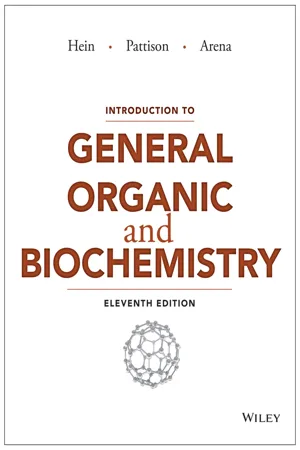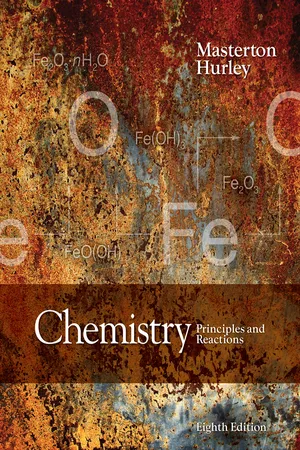Chemistry
Skeleton Equation
A skeleton equation in chemistry is a simplified representation of a chemical reaction that only includes the chemical formulas of the reactants and products. It does not show the relative amounts of each substance involved in the reaction. This type of equation is a starting point for balancing chemical equations by adding coefficients to represent the correct stoichiometry.
Written by Perlego with AI-assistance
Related key terms
1 of 5
4 Key excerpts on "Skeleton Equation"
- eBook - PDF
- Morris Hein, Susan Arena, Cary Willard(Authors)
- 2016(Publication Date)
- Wiley(Publisher)
To represent the quantitative relationships of a reaction, the chemical equation must be balanced. A balanced equation contains the same number of each kind of atom on each side of the equation. The balanced equation therefore obeys the law of con- servation of mass. Every chemistry student must learn to balance equations. Many equations are bal- anced by trial and error, but care and attention to detail are still required. The way to balance an equation is to adjust the number of atoms of each element so that they are the same on each side of the equation, but a correct formula is never changed in order to balance an equation. The general procedure for balancing equations is as follows: CHECK YOUR UNDERSTANDING 8.1 Law of Conservation of Mass ➥ PROBLEM-SOLVING STRATEGY For Writing and Balancing a Chemical Equation 1. Identify the reaction. Write a description or word equation for the reaction. For exam- ple, let’s consider mercury(II) oxide decomposing into mercury and oxygen. mercury(II) oxide ⎯→ ∆ mercury + oxygen Correct formulas are not changed to balance an equation. Study this procedure carefully and refer to it when you work examples. EXAMPLE 8.1 Classify each formula in the chemical reactions below as a reactant or a product. (a) MnO 2 + 4 HCl ⎯→ MnCl 2 + Cl 2 + 2 H 2 O (b) Na 2 SO 3 + H 2 SO 4 ⎯→ Na 2 SO 4 + SO 2 + H 2 O SOLUTION (a) Reactants: MnO 2 and HCl Products: MnCl 2 , Cl 2 , and H 2 O (b) Reactants: Na 2 SO 3 , and H 2 SO 4 Products: Na 2 SO 4 , SO 2 , and H 2 O P R A C T I C E 8 . 1 How is a substance in a chemical equation identified as a solid, a gas, or in a water solution? LEARNING OBJECTIVE KEY TERMS balanced equation ONLINE LEARNING MODULE Analyzing Chemical Equations ➥ 150 CHAPTER 8 • Chemical Equations 2. Write the unbalanced (skeleton) equation. Make sure that the formula for each sub- stance is correct and that reactants are written to the left and products to the right of the arrow. - eBook - PDF
- Morris Hein, Susan Arena, Cary Willard(Authors)
- 2021(Publication Date)
- Wiley(Publisher)
To represent the quantitative relationships of a reaction, the chemical equation must be bal- anced. A balanced equation contains the same number of each kind of atom on each side of the equation. The balanced equation therefore obeys the law of conservation of mass. Every chemistry student must learn to balance equations. Many equations are balanced by trial and error, but care and attention to detail are still required. The way to balance an equation is to adjust the number of atoms of each element so that they are the same on each side of the equation, but a correct formula is never changed in order to balance an equation (see note). The general procedure for balancing equations follows. Study this procedure care- fully and refer to it when you work examples. CHECK YOUR UNDERSTANDING 8.1 Law of Conservation of Mass Note Correct formulas are not changed to balance an equation. EX AMPLE 8.1 Classify each formula in the chemical reactions below as a reactant or a product. a. MnO 2 + 4 HCl ⟶ MnCl 2 + Cl 2 + 2 H 2 O b. Na 2 SO 3 + H 2 SO 4 ⟶ Na 2 SO 4 + SO 2 + H 2 O Solution a. Reactants: MnO 2 and HCl Products: MnCl 2 , Cl 2 , and H 2 O b. Reactants: Na 2 SO 3 , and H 2 SO 4 Products: Na 2 SO 4 , SO 2 , and H 2 O PR AC TICE 8.1 How is a substance in a chemical equation identified as a solid, a gas, or in a water solution? Try a similar problem in PROBLEM SOLVING VIDEO Analyzing Chemical Equations 158 CHAPTER 8 Chemical Equations Problem-Solving Strategy For Writing and Balancing a Chemical Equation 1. Identify the reaction. Write a description or word equation for the reaction. For example, let’s consider mercury(II) oxide decomposing into mercury and oxygen. mercury (II) oxide Δ ⟶ mercury + oxygen 2. Write the unbalanced (skeleton) equation. Make sure that the formula for each substance is correct and that reactants are written to the left and products to the right of the arrow. - Morris Hein, Scott Pattison, Susan Arena, Leo R. Best(Authors)
- 2014(Publication Date)
- Wiley(Publisher)
Chemical reactions always involve change. Atoms, molecules, or ions rearrange to form dif- ferent substances, sometimes in a spectacular manner. For example, the thermite reaction is a reaction between aluminum metal and iron(III) oxide, which produces molten iron and alumi- num oxide. The substances entering the reaction are called the reactants, and the substances formed are called the products. In our example, reactants aluminum iron(III) oxide products iron aluminum oxide During reactions, chemical bonds are broken and new bonds are formed. The reactants and products may be present as solids, liquids, gases, or in solution. In a chemical reaction atoms are neither created nor destroyed. All atoms present in the reactants must also be present in the products. A chemical equation is a shorthand expression for a chemical change or reaction. A chemical equation uses the chemical symbols and formulas of the reactants and products and other symbolic terms to represent a chemical reaction. The equations are written according to this general format: 1. Reactants are separated from products by an arrow ( ¡) that indicates the direction of the reaction. The reactants are placed to the left and the products to the right of the arrow. A plus sign ( + ) is placed between reactants and between products when needed. Al + Fe 2 O 3 ¡ Fe + Al 2 O 3 reactants products 2. Coefficients (whole numbers) are placed in front of substances to balance the equation and to indicate the number of units (atoms, molecules, moles, ions) of each substance react- ing or being produced. When no number is shown, it is understood that one unit of the substance is indicated. 2 Al + Fe 2 O 3 ¡ 2 Fe + Al 2 O 3 3. Conditions required to carry out the reaction may, if desired, be placed above or below the arrow or equality sign. For example, a delta sign placed over the arrow ( S ) indicates that heat is supplied to the reaction.- eBook - PDF
Chemistry
Principles and Reactions
- William Masterton, Cecile Hurley(Authors)
- 2020(Publication Date)
- Cengage Learning EMEA(Publisher)
In a balanced chemical equation, there are the same number of atoms of a given element on both sides. The same situation holds for a chemical reaction that you carry out in the laboratory; atoms are conserved. For that reason, any calculation involving a reaction must be based on the balanced equation for that reaction. Beginning students are sometimes led to believe that writing a chemical equation is a simple, mechanical process. Nothing could be further from the truth. One point that seems obvious is often overlooked. You cannot write an equation unless you know what happens in the reaction that it represents. All the reactants and all the products must be identified. Moreover, you must know their formulas and physical states. To illustrate how a relatively simple equation can be written, consider liquid hydrazine (N 2 H 4 ). It was used to fuel the rocket engines for the Mars rover Curi-osity, which landed on Mars in August 2012. It is still there (Figure 3.9). Hydra-zine can react with liquid dinitrogen tetroxide to produce gaseous nitrogen and water vapor. To write a balanced equation, proceed as follows: 1. Write a “skeleton” equation in which the formulas of the reactants ap-pear on the left and those of the products on the right . In this case, N 2 H 4 1 N 2 O 4 9: N 2 1 H 2 O 2. Indicate the physical state of each reactant and product, after the for-mula, by writing ( g ) for a gaseous substance ( l ) for a pure liquid ( s ) for a solid (aq ) for an ion or molecule in water (aqueous) solution Figure 3.9 Mars rover Curiosity. ANALYSIS Information given: simplest formula (C 3 H 4 O 3 ) MM a —actual molar mass (176 g/mol) Asked for: molecular formula STRATEGY 1. Determine the molar mass of the simplest formula, MM s . 2. Find the ratio actual molar mass simplest formula molar mass 5 MM a MM s 3. To get the molecular formula, multiply all subscripts in the simplest formula by the ratio.
Index pages curate the most relevant extracts from our library of academic textbooks. They’ve been created using an in-house natural language model (NLM), each adding context and meaning to key research topics.



